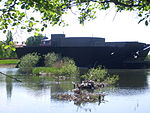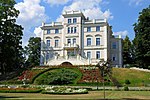Burgwall Island (Feisnecksee)

Burgwall Island (German: Burgwallinsel) is an island in the Feisneck lake in the southeast part of the town of Waren (Müritz) in the German district of Mecklenburgische Seenplatte. The name means "castle mound" or "motte". Burgwall Island lies in a small lake, which has an area of 1.94 km². Its name is derived from a castle on the island, only remnants of which remain. It was a typical island castle from the Slavic era. As finds of pottery have shown, the site was already settled during the Old Slavic period of the 7th and 8th centuries and continued to exist until the 12th century. Finds of early German pottery indicated that the island continued to be used after Christianity had been introduced in the Middle Ages. Whether the castle still existed then is not known. The castle site lay in the territory of the Müritz tribe that, during the 10th century, periodically belonged to the Lutici federation. Today the remains of a rampart may still be made out in the southern part of the wooded island. It looks as if most of it was carried away in the preceding centuries.
Excerpt from the Wikipedia article Burgwall Island (Feisnecksee) (License: CC BY-SA 3.0, Authors, Images).Burgwall Island (Feisnecksee)
Federower Weg,
Geographical coordinates (GPS) Address External links Nearby Places Show on map
Geographical coordinates (GPS)
| Latitude | Longitude |
|---|---|
| N 53.49417 ° | E 12.70722 ° |
Address
Burgwall
Federower Weg
17192
Mecklenburg-Vorpommern, Germany
Open on Google Maps







